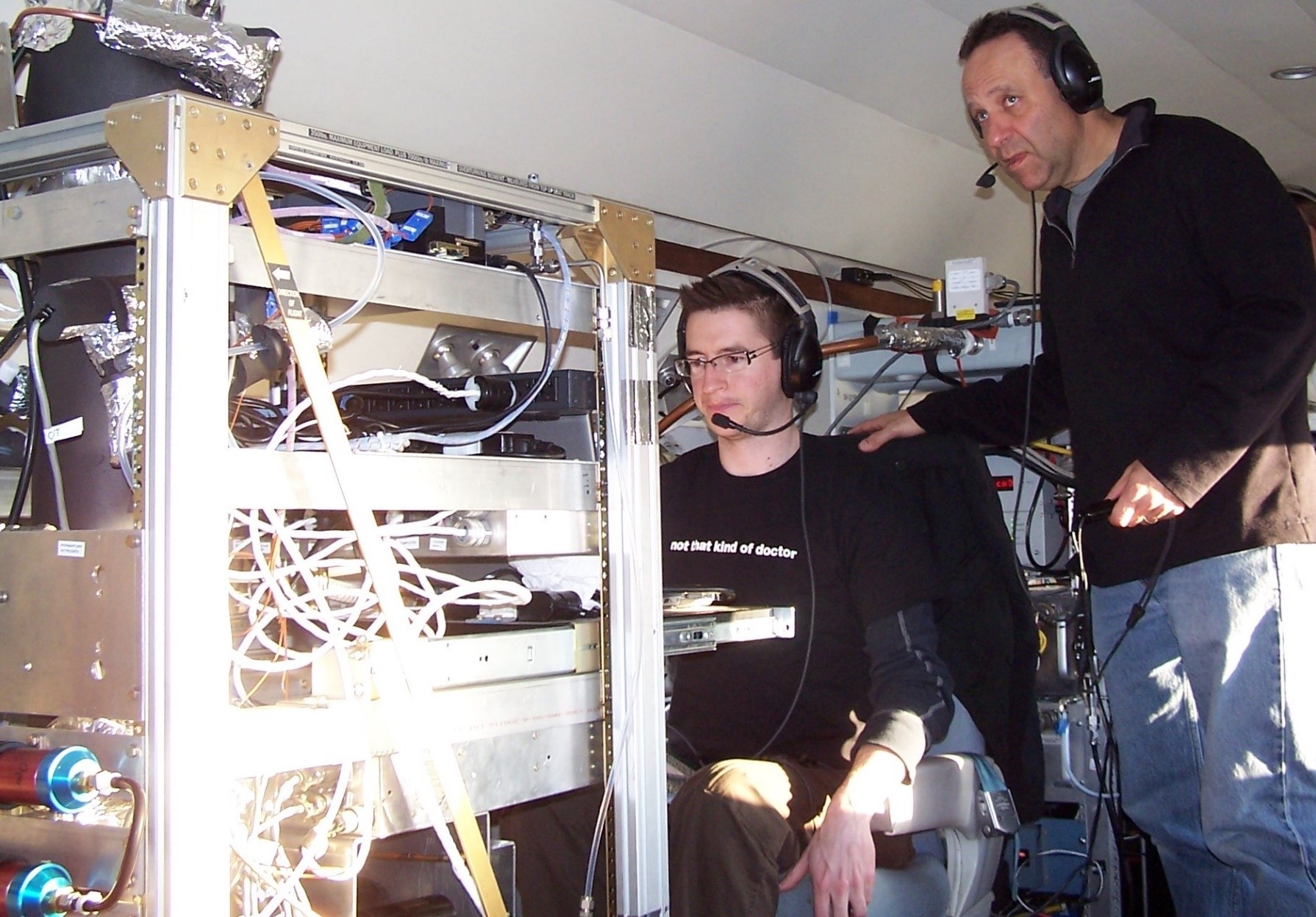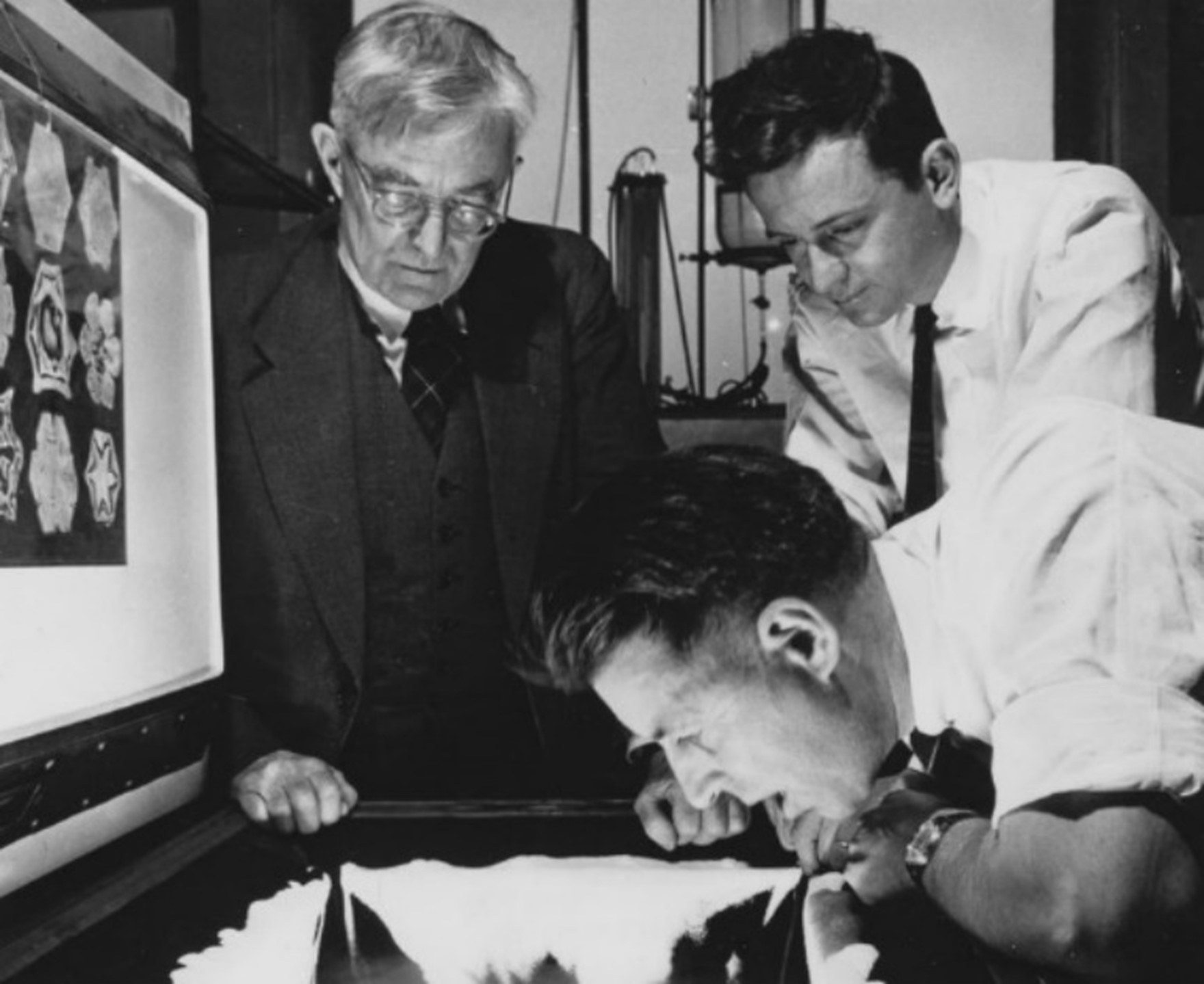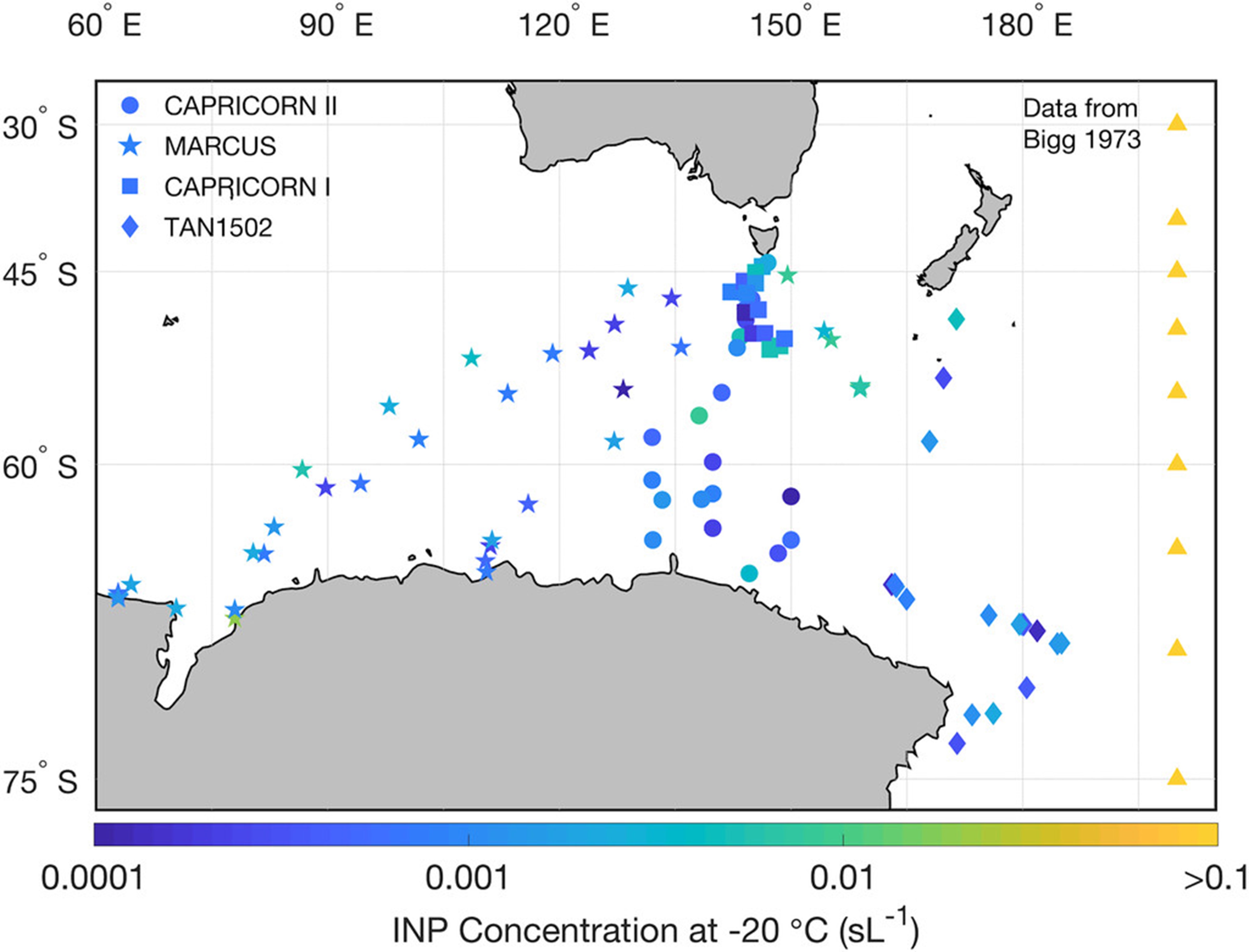
A veteran Colorado State University researcher witnessed the rise and fall and rise again of scientific interest in ice-nucleating particles
This is the second of a two-part ASR profile of Paul DeMott, an influential student of atmospheric ice and ice-nucleating particles. Read part 1 here.
World War II was not quite over when Bernard Vonnegut joined a team of scientists in Minneapolis. They used a repurposed B-24 bomber to study atmospheric ice―especially how and when it would ice over the aircraft’s wings.
During every research flight, an Army Air Corps sergeant would lower a little machine with rotating cylinders into freezing clouds through the B-24’s bomb bay doors. The device, which measured water content and droplet size, was the brainchild of Vonnegut.
He was the tinkering, practical son of an Indiana architect brought to the war effort a doctorate from the Massachusetts Institute of Technology. His dissertation was entitled “A Freezing Point Apparatus.”
After the war, Vonnegut brought his fascination with clouds and ice and tinkering to General Electric (where he helped seed clouds to manufacture snow) and then to the State University of New York at Albany.
It was at Albany in the 1970s that Paul DeMott, then an undergraduate student in atmospheric science, encountered Vonnegut, who was co-instructing a class on instruments.
Today, DeMott is a veteran cloud-ice expert in Colorado State University’s atmospheric chemistry program. About half of his current projects are funded by the Atmospheric System Research (ASR) program at the U.S. Department of Energy (DOE). Many also use data collected by Atmospheric Radiation Measurement (ARM), a DOE Office of Science user facility with observatories in climate-critical regions across the globe.
DeMott has many dozens of projects and papers and mentored students behind him. But he often thinks of Vonnegut and a cohort of old-time ice researchers as the lineage of scholars who sent him on his way―into the clouds to research the mysteries of ice formation.
Cloud Seeding
Ice-nucleating particles (INPs) are tiny―measured in fractions to multiples of a micron. But the size of these bits of mineral dust or fractured biomass belies their importance. INPs influence how clouds form, how much sunlight they reflect, and how long clouds live.
In turn, ice nucleation―how INPs seed ice in clouds―is a critical avenue of research. Scientists know that such nucleation can happen heterogeneously―when a very cold droplet of water freezes and grows (crystalizes) around an INP.
When Bernard Vonnegut was a young man, a generation of scientists had already investigated ways to make snow or rain with artificial particles. Some techniques included a whiff of crackpot. In 1891, the first government-funded efforts to make rain involved exploding dynamite in the sky.
By the middle of the 20th century, scientists who were experimenting with cloud-seeding synthetics to promote rain or snow where there was too little.
DeMott knew and studied with some of these cloud-seeding pioneers when he was an undergraduate at Albany (B.S., 1979). It was Vonnegut, for instance, who in 1946 discovered the rain-making potential of silver iodide.
“He was one of the most influential people in leading me into my science career,” says DeMott.
Interest Turns Down, Then Back Up

In 1979, DeMott was a young graduate student at Colorado State University (PhD, 1990). It was a time when interest in ice nucleation began to flare out after its heyday in the 1950s and 1960s.
Despite the downturn in community interest and funding, his own interest persisted.
“I knew when I was young,” says DeMott in a mid-career video interview, “this was a major topic in the area of cloud physics.”
By 2011, interest in ice nucleation was back at the scientific forefront. A revival of energy around the topic had taken a decade of workshops and international exchange of ideas. During this period, DeMott gave invited talks and joined conferences in France, Italy, Germany, Japan, and elsewhere.
In December 2011, he led a landmark article on why interest in ice nucleation had fallen into a long lull. The study also explained the resurgence of attention. By 2011, says DeMott, interest had reached a “historically unparalleled level” and today “has continued unabated.”
There are better measurements than ever. There is more synergy with models, a larger constituency of researchers, and more workshops. There are also many more papers and a better understanding of secondary ice-formation processes.
Moving Beyond Weather Modification
Another, in 1990, professed his abiding interest in ice-nucleating field experimentation and weather modification operations that use it.
By the mid-1990s, much of the interest in ice-crystal weather modification research had vanished, along with funding. But at the same time, interest in natural ice-nucleation processes had revived as part of a burgeoning interest in climate studies. That revival of interest included more investigations of clouds, which were (and remain) a source of great uncertainty in models.
There was increased interest in natural particles thought to nucleate ice in clouds. These include bacteria, bits of fungi, mineral dusts, sea spray, and more. Typically, such particles are swept into the atmosphere by wind, splashing rain, or oceanic wave action.
In a 1990 paper, DeMott used a cloud chamber to investigate soot particles as a means of ice nucleation. He also looked at the soot particles as a proxy for anthropogenic aerosols that unintentionally might seed ice formation.
Inspiration from Vonnegut

During his boyhood in Elmira, New York, DeMott acquired an interest in rivers, floods, and weather. He also attended a Roman Catholic parochial high school, where his inclination toward science was nurtured.
“I had two of the most fantastic teachers for math and chemistry,” he remembers. “I saw a very different side of Catholic nuns than one hears in stories. They took personal interest in me. They kept me on task.”
In 1975, DeMott crossed the state on an easterly diagonal to attend college in Albany. By his junior year, he had tried both math and physics majors.
With high energy physics looming as a likely career path, “I wanted to do something more tangible,” says DeMott.
Meanwhile, his searching mind also explored undergraduate courses in geography, language, literature, history, and music.
Along came an inspirational course on instrumentation in atmospheric science, co-taught by Vonnegut and Garland Lala, now a professor emeritus.
“Bernie (Vonnegut) was fascinating because he would use the very simplest possible devices you could build.”
That included making a rain gauge from a discarded orange juice can. It was wrapped with wire to measure the change in current.
How Precipitation Starts
At the same time, Vonnegut related his early days of doing cloud-seeding experiments at General Electric.
“I found that one of the most interesting topics as the basis for how precipitation starts,” says DeMott.
His undergraduate advisor ended up being atmospheric scientist and hailstorm expert Narayan R. Gokhale, an ice-nucleation researcher.
“That was the lineage that led to my career,” he says.
But it was a casual conversation with Vonnegut that pointed DeMott to Colorado State.
At the time, under the direction of Lewis O. Grant, the university had a solid PhD program, active programs in weather modification, and atmospheric chambers for laboratory-scale experiments.
Hungry for Hands-On
“I was most hungry to get hands-on experience in atmospheric science,” says DeMott of his 1979 decampment to Colorado. “That’s what led me to graduate school.”
Fort Collins, Colorado, was about a quarter of the size then as it is now.
“It had a cowboy-town image,” he says, “not that much different than the small city in Western New York I grew up in. But it was very much ‘get outdoors, climb a mountain.’ It was perfect for me.”
DeMott still bikes to work every day. In winter, he says, “I just put the gear on and live with it.”
Graduate school, however, was “a rude awakening” of constant work, says DeMott.
He joined an active cloud microphysics group, where some research was going on in weather modification in mountainous terrain.
During his first semester, DeMott flew in a Lear jet over the Colorado Rockies as part of orographic cloud seeding research, which continued into the mid-1980s. As part of that effort, he helped with the early development of the present Storm Peak Laboratory.
His master’s degree thesis was under the direction of chemist and ice-nucleation researcher William G. Finnegan. It involved cloud-chamber experiments on “new types of cloud-seeding materials,” he says, “and their efficacy for making ice in clouds.”
That was the early 1980s, which marked “the tail end of heavy research on weather modification,” says DeMott, when the number of related publications “just went flat.”
A Delay, with Benefits

DeMott delayed finishing his PhD dissertation because he lost one advisor to retirement and another to a career move.
In the interval, DeMott worked as a Colorado State research associate. He continued to support the testing of cloud seeding materials for the operational weather modification community and submitting his first research proposals.
He also did some atmospheric consulting work. In one case, DeMott investigated the potential use of a bacterial-based ice-nucleating material, Snowmax®, for cloud seeding, with support from an Eastman Kodak spinoff. This product is still used to make artificial snow at ski resorts, but its use for cloud seeding applications never took off.
Artificial ice-nucleating particles served as the basis for his dissertation, which investigated and parameterized the varied mechanisms by which they can act. DeMott simulated a dynamic parcel of rising air in what he says was one of the first-ever controlled-expansion cloud chambers in the world.
In the chambers, adds DeMott, he used “some of the better materials identified in the master’s degree work.”
But it was Snowmax® “that seeded my interest in biological ice-nucleating particles,” he says, along with “the remarkable idea that biological aerosols can travel in the air around the world,” something that continues to inspire his research.
About the time DeMott finished his dissertation in 1990, Sonia M. Kreidenweis stepped in as DeMott’s supervisor. (He still works in her group at Colorado State.)
This was also when DeMott worked with David C. Rogers to transform one of the first-ever continuous-flow diffusion chambers (CFDCs) into a fully capable aircraft-based instrument for ice-nucleation research.
To date, he says, the diffusion chamber, as both a ground and airborne device, “has collected the most atmospheric data of any real-time ice-nucleation instrument in history.”
Field Studies
When DeMott helped modify the CFDC for airborne research, around 2001, he solidified his transition from laboratory to field.
Starting in the late 1990s, he says, “I really wanted to get out and make measurements in the atmosphere.”
Getting airborne, especially, is “where we need to validate things,” adds DeMott. “There’s only so far you can go with making a measurement on the ground.”

By 1996, DeMott and Rogers had test-flown the CFDC and were part of a NASA airborne campaign. DeMott went on to lead the first research flight for a DOE field campaign, in Alaska, during ARM’s 2004 Mixed-Phase Arctic Cloud Experiment (M-PACE).
He prepared installations and test flights. Colorado State colleague Anthony Prenni was a flight scientist on the University of North Dakota’s Citation aircraft. Along for the ride was the CFDC, which sampled INPs via an aerosol inlet.
Airborne Aerosol Measures
In 2011, DeMott took part in ARM’s CALWATER field campaign. It was an investigation of how aerosols―some from as far away as Asia and Africa―impact clouds and precipitation in California’s Sierra Nevada mountains. He again brought the airborne version of the CFDC diffusion chamber, this time aboard ARM’s Gulfstream-159 (G-1) research aircraft.
Phase two of this effort came in 2015 during the ARM Cloud Precipitation Field Experiment (ACAPEX) campaign.
ACAPEX marked the first full airborne deployment of the filter-based systems for offline ice-nucleation measurements. Today, they are the basis of the DOE-ARM mentor ice-nucleation program.
Both CALWATER and ACAPEX included the novel use of a counterflow virtual impactor to sample and activate cloud residual nuclei in addition to ambient aerosols. In parallel to the impactor, both campaigns used an aerosol time-of-flight mass spectrometer (ATOFMS) to correlate INP data with single-aerosol particle compositions.
CALWATER and ACAPEX analyses illustrate close collaborations between DeMott’s team and the Kimberly Prather group at the University of California, San Diego.
Meanwhile, using the impactor and ATOFMS in tandem was the key to “understanding INP and aerosol relations,” says DeMott.
To illustrate, he pointed to two papers he coauthored.
The first is the same 2013 Science study that reported on the African and Asian dust that influence precipitation in the American West.
The second paper, from 2019, referenced both CALWATER and ACAPEX. It investigated INP types transported in atmospheric river events during some 2015 winter storms in California.
INP Papers Pour Out

In 2021 and 2022, DeMott’s work on INPs continued at a fast pace. His output included contributions to at least five papers funded by ASR projects.
An April 2021 paper reviewed four field campaigns conducted aboard instrumented ships in the Southern Ocean. Two were funded by ASR and used ARM assets: the land-based Macquarie Island Cloud and Radiation Experiment (MICRE) and the ship-borne Measurements of Aerosols, Radiation, and Clouds over the Southern Ocean (MARCUS) campaign over periods from 2017 and 2018. DeMott was on a 2014 team that developed plans for both these studies.
The Southern Ocean is a largely pristine environment. INPs are hard to find. Those that can be found originate predominantly from sea spray infused with bits of organic matter.
Collectively, the four campaigns compiled the most comprehensive INP measurements in the region since 1973. The INP dataset must still be fully explored. But so far, readings from within the lower boundary layer reveal generally low INP concentrations―which get higher when closer to landmasses.
A September 2021 paper DeMott coauthored relied on data collected during ARM’s 2018-2019 Cloud, Aerosol, and Complex Terrain Interactions (CACTI) field campaign in the Sierras de Córdoba mountains of Argentina, where the world’s tallest thunderstorms form. Until CACTI, there was little data on the life cycles of convective clouds in such regions.
CACTI scientists collected INP samples on ground-based and airborne filters. Later, at Colorado State, these were used for immersion freezing measurements with an ice spectrometer.
A second 2021 CACTI paper using these data appeared in November 2021. It investigated the multi-season links between INP concentrations to weather and land-surface emissions. The authors observed no seasonal concentration cycle and reported that inorganic INPs mainly played a minor role. They linked the dominant biological and organic INPs to regional agricultural soil sources.
Persistence in 2022
DeMott was part of a January 2022 paper on a modeling framework to estimate marine INPs in the sea surface microlayer. The interface between ocean and atmosphere is chemically and biologically distinct from underlying water. The microlayer controls the oceanic emissions of aerosolized organic matter into the atmosphere. This film-like layer can be as thin as 1 micron. (Specks of house dust are about 50 microns wide.)
The framework, designed by lead author Isabelle Steinke of Pacific Northwest National Laboratory (PNNL), is a way to identify oceanic INPs concentrations and their transfer to the atmosphere. The authors acknowledge that big knowledge gaps remain about the identity of INPs in the microlayer. They also call for targeted observations, as well as modeling studies that focus on how marine INPs impact clouds.
The latest 2022 INP-related paper has been accepted by Reviews of Geophysics but has yet to appear. It’s led by Susannah Burrows of PNNL, with DeMott as senior author.
The study promises to spell out observations and modeling research needs on INPs that impact clouds and climate. It is also the latest sign that interest in INPs is firmly here to stay.
Way back, when ice-nucleation research had plateaued in the 1980s and early 1990s, DeMott even then kept adding to the literature.
“I was persistent, you might say,” he says. “Other people might say crazy.”
# # #Author: Corydon Ireland, Science Writer, Pacific Northwest National Laboratory
This work was supported by the U.S. Department of Energy’s Office of Science, through the Biological and Environmental Research program as part of the Atmospheric System Research program.

